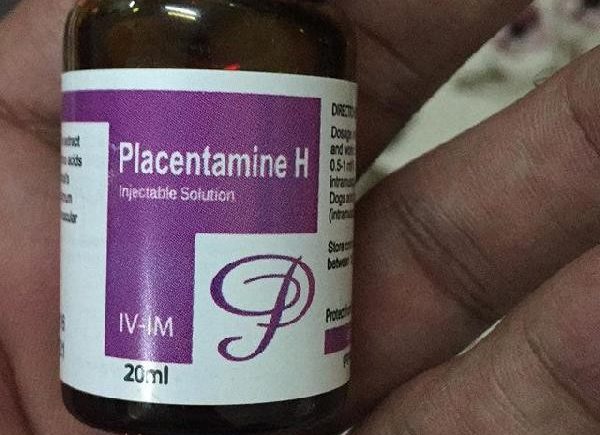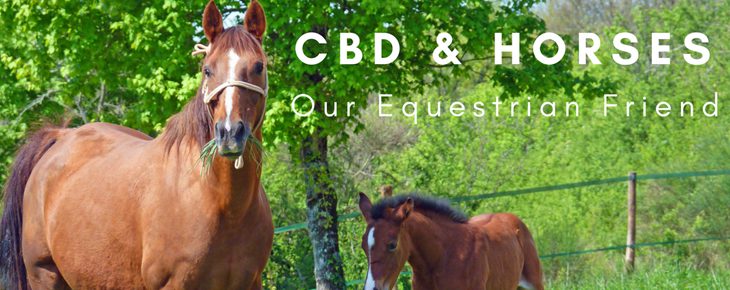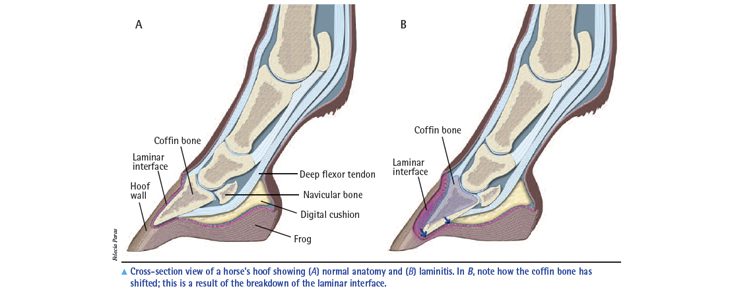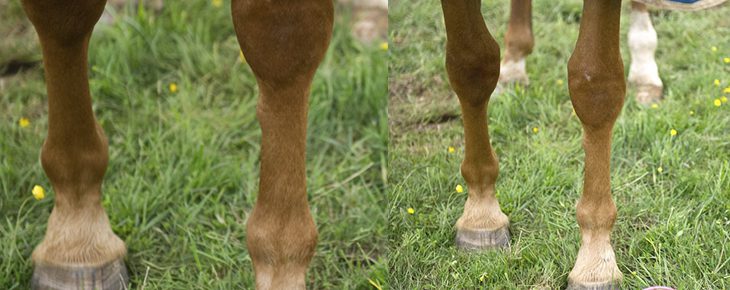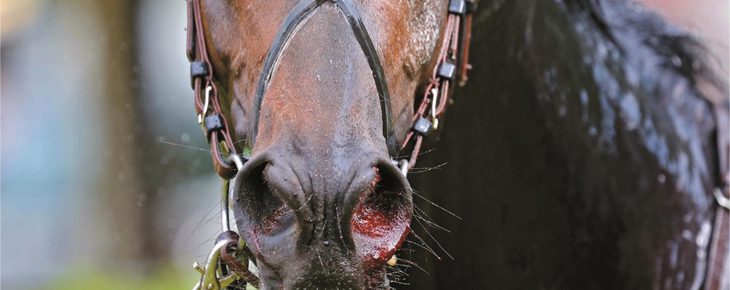Author: Admin
What are Cannabinoids?
Cannabinoids are chemical compounds that are found in cannabis and hemp. They match and map to endocannabinoids in the ECS (Endocannabinoid System) found in all mammals. These systems are not identical across each species, but they do function in much the same way.
Phytocannabinoids trigger an entire inventory of medical therapeutic applications. THC is the best known of all of these elements, but it’s the one that produces the psychoactive effects that placed it on the FDA’s Schedule 1 of drugs. Hemp, on the other hand, has less than .3% THC, and more importantly, Hemp-extracted CBD-oil is legal in all 50 states.
The ECS is common to mammals. It involves their brains, nervous systems, organs and immune systems in many extensive and complex ways. The prescription medications used to treat medical conditions must be processed by the horse’s physiology, but cannabinoids and phytocannabinoids are simply assimilated.
Cannabinoids and their effects on animals:
An extremely extensive study done in 1999 about Cannabinoids and Animal Physiology concluded with the following highlights:
“Cannabinoids likely have a natural role in pain modulation, control of movement, and memory.
The natural role of cannabinoids in immune systems is likely multi-faceted and remains unclear.
The brain develops tolerance to cannabinoids.
Animal research has demonstrated the potential for dependence, but this potential is observed under a narrower range of conditions than with benzodiazepines, opiates, cocaine, or nicotine.
Withdrawal symptoms can be observed in animals but appear mild compared with those of withdrawal from opiates or benzodiazepines, such as diazepam (Valium).”
The research has been focused on the reaction of lab animals, but there are fundamental commonalities in the physiology of lab animals, domestic pets and livestock.
Cannabinoids and their effects on horses:
Horses constantly live in a state of “fight or flight.” They have instinctive fears of falling or tripping. Having no ability to see behind them, they worry about what’s going on behind them… and if you have been around horses enough, you realize they really would prefer to run wild.
In addition to their anxiety and stress, horses are subject to a large amount of medical problems: arthritis, herd bound issues, muscle soreness, chronic laminitis, stall rest, trailering stress and much more.
Equine Arthritis: Aging horses develop Degenerative Joint Disease (DID) along with Traumatic Joint Disease – that appears as pain, swollen joints, and stiffness.
Chronic Laminitis: According to the American Association of Equine Practitioners -Laminitis results from the disruption of blood flow to the sensitive and insensitive laminae. These laminae structures within the foot secure the coffin bone to the hoof wall. Inflammation often permanently weakens the laminae and interferes with the wall-bone bond. In very severe cases, the hoof wall and bone can separate. Among other causes, laminitis relates to aging, digestive issues, and severe colic.
Herd Bound Issues: Horses are prey animals that find comfort in membership in a herd with other horses. They are social in their fear, so they suffer anxiety when separated from the horse social circle.
Muscle Soreness: Horses suffer muscle pain and strain, especially after exercise. It is usually relieved with physiotherapy and rest. Riders and owners are often unaware of the pain horses feel around the saddle area and in their legs following an active ride.
Stall Rest: Equiresearch explains, “Weeks of cooped-up idleness can make your horse aggressive, anxious, or dull, and can even interfere with his healing unless you anticipate and counteract the effects of confinement.”
Trailering Stress: Horses, for the most part, are claustrophobic. As a prey animal, they instinctively prefer wide open spaces. Tight, mobile areas stress them because they restrict an escape route and even the room to turn around. In addition to that, horses have long memories of uncomfortable and unstable rides from their past.
CBD (cannabidiol) has proven beneficial effects for all these conditions and more. In horses and other mammals, CBD-rich extracts can help to treat:
- Anxiety
- Inflammation
- Chronic Pain
- Separation Anxiety/ Generalized Anxiety
- Digestion and Appetite
- Arthritis
- Nausea
- Seizures
The values in CBD Oil:
CBD is the non-psychoactive compound found in the cannabis sativa plant and hemp. CBD oil is an extract that does NOT include the psychoactive THC. Equine researchers and veterinarians have become very interested in the health benefits following the administration of full-spectrum CBD oil.
Full-spectrum CBD oil for horses will act as an analgesic, anti-inflammatory, anti-anxiolytic, anticonvulsant antiemetic, and anti-tumoral therapy. It produces no negative side effects and it can be administered orally.
Due to its strictly natural origin and production, the FEI and U.S. Equestrian Federation (USEF) do not list it as a prohibited supplement in competition rules (although you may want to double check the regulations at your local competition).
At its core, CBD oil treats a broad spectrum of anxiety related issues in horses, thoroughbreds, quarter horses and also pets.
What is Founder?:
Founder occurs due to the lack of blood flow in the laminae which produces inflammation in the hoof. As time goes by, the cells of the laminae are damaged due to the lack of oxygen and nutrients that are found in the blood. If the problem is not treated in the early stages of founder, the laminae will start to die and cause more problems along with pain. When the laminae die, the coffin bone can no longer support the weight of the horse. Sometimes the coffin bone can protrude through the sole, resulting in a possible irreversible case of lameness and excruciating pain.
Founder (aka laminitis) in horses is a very serious condition of the foot caused by the coffin bone rotating and pointing towards the horse’s sole. This is extremely painful and in some instances it may be necessary to euthanize the horse.

The Symptoms of Founder in Horses:
Founder can happen in any of hoof, but most often it happens in the front. Some of the most common signs and symptons of founder are:
- Sudden lameness
- Reluctance to walk or move
- Laying down more often
- Pulse felt in the foot Alternating weight from leg to leg Does not want to lift, bend, or raise a leg
- Warm/hot hoof
- Obvious pain when standing or moving
- Standing with front legs out in front of their body
- Movement or rotation of coffin bone
- Standing with both front and rear legs under their body
Types Of Founder:
- Acute founder is the sudden breakdown of the attachment between the hoof and the laminae (coffin bone)
- Chronic founder is the continuation of acute laminitis past the 72 hourmark
- Support-limb founder happens to the healthy hoof that must bear the weight of an injured hoof
The Causes of Founder:
- Feeding your horse large amounts of soluble carbohydrates could cause an overload of undigested sugars and starches
- High fever or illness that causes equine metabolic syndrome (EMS)
- Severe cases of colic such as stress from travelling, foaling, or changes in the horses environment
- Infections such as a severe bacterial infection can cause blood poisoning (toxemia) and founder
- Working too hard or fast for a long period of time
- Cushing’s disease is a pituitary gland disease that causes increased hunger, thirst, sweating, and weight loss… and possibly founder.

Diagnosis of Founder:
Be prepared to tell your veterinarian your horse’s medical history along with their vaccination history. This will give your vet a head start prior to a comprehensive physical and lameness examination which includes palpation of certain areas for pain, heat, and inflammation. A static flexion will also be done to check out the range of motion. The veterinarian will ask you to trot your horse off to observe the horse in motion. A hoof tester is used next to put pressure on certain areas of the foot to find the exact location. In addition, the veterinarian will need to get x-rays of the hoof to check the alignment of the coffin bone and may also do an ultrasound as well for a more detailed view.
Treatment of Founder in Horses Treatment of founder depends on the cause. The underlying problem must be treated at the same time to ensure success.
Medications To Be Used:
Your veterinarian will first administer a non-steroidal anti-inflammatory drug (NSAID) to relieve inflammation and pain. A thyroid supplement will be given only if your horse is found to have Cushing’s disease. Heel wedge Cuffs, heart bar shoes or foam supports can be used for support. Sole putty can be used from the heels to the tip of the frog to provide support to the frog.
Cold Therapy– A MUST:
The number one way to administer cold therapy is by immersing your horse’s hoof in ice water on and off for at least three full days. Twenty minutes in ice, then thirty minutes out and keep repeating. You will have to consistently replace the ice to keep the water temperature below 40 degrees Fahrenheit.

Absolute Stall Rest:
Keep your horse in a quiet stall with enough bedding to support the frog. Your veterinarian will most likely suggest this for at least one week to one month.
Surgery Options:
There are few options for surgery such are a hoof wall resection or deep digital flexor tenotomy.
Recovery of Foundered Horses:
The prognosis for a foundered horse is guarded. While some horses may be able to withstand the treatment or even heal on their own, others may never come sound and be in constant pain and therefore may need to be euthanized.
The fracture of a splint bone in the horse is a reasonably common occurrance. The splint bone plays an important role in the stability and support of the knees and hocks, therefore it is important that all fractures involving them are treated immediately.

Causes of Splint Bone Fractures:
Fractures of the bottom third of the splint bone are what is most common and they are usually the result of internal trauma by over extending the fetlock joint. This will occur when the affected leg is fully weight bearing and the fetlock is at its lowest point of the horses stride.
This results in stress being placed on the bone, between the attachments to the cannon bone at one end and the attachments to the fetlock at the other end. These fractures will usually occur in horses at around five to eight years of age when the splint bone has lost some flexibility.
Strain of the suspensory ligament will often occur hand in hand with these bottom third fractures because similar stress is being placed on the ligament.
Another possible way that the splint bone will break is when the suspensory strain will be what causes the splint bone to fracture as the injured suspensory ligament pushes the splint bones outwards during flexion of the fetlock.
Conformation, which can lead to interference – (where one limb strikes another during work) will predispose horses to fracture their inside splint bones. A excellent example are knocked kneeed horses where the limb angles outwards below the knee. Horses with unbalanced feet -where inside and outside hoof walls are different lengths – may be more likely to suffer lower splint fractures.
The Warning Signs Of Fracture:
There will be swelling over the inside and/or outside of the cannon bone, heat, pain to the touch and lameness and are all signs that a splint bone may have been fractured.
Simple fracture lameness isn’t always noticeable in a straight line trot, whereby lunging or faster work may be required to detect any lameness.
Diagnosing a fracture:
The signs of a fracture as described above will suggest a fracture may have occurred. X-rays will need to be taken to give a positive diagnosis of the injury.
An ultrasound scan should also be done to see if there is any suspensory ligament strain that occurred at the same time as the fracture of the bottom third of the splint bone.

Treatment Of The Injury:
If there is an obvious swelling of the leg when the initial injury occurs, place ice on the area for 15-20 minutes before placing a very well padded pressure bandage over the area until your vet can examine your horse.
Low fractures: The usual treatment for bottom third fractures is to surgically remove the broken bottom piece of bone and round off the end of the remaining portion. This is still the most preferred way of treating this type of fracture in most cases. This allows the horse to be back to work fairly quickly (if there is no suspensory injury) after surgery.
If the fractured portion of bone is not displaced and is stable, then stall rest along with a pressure bandage will heal the injury perfectly. Recovery period will be longer for the horse with this treatment.
Higher fractures: More complicated fractures that involve the upper third of the splint bone will require surgery to repair the top part of the splint bone in place so downwards pressure from the knee or hock does not cause continual movement of the splint bone – which causes irritation and increased lameness. This is achieved by using stainless steel screws (which affix the splint bone to the cannon bone) or sometimes a combination of screws along with a steel plate.
If there is an open wound over the fractured area, the wound and bone often become infected therefore treatment with antibiotics and antibiotic dressings are necessary to control the infection before any surgery can take place. Given the proper amount of time, these fractures could possibly heal themselves and surgery may not be necessary.

The Recovery Rate:
After treatment is completed, the chances of your horse returning to their previous level of work once is usually very good. If the suspensory ligament has also been strained, then the period off of work will be much longer (possibly many months) and there is a higher likelihood of lameness reoccurring to the suspensory ligament.
When starting a horse back to work again their exercise needs to be built up gradually – starting with just walking twice a day and slowly working up from there.
Points Of Action:
If you do suspect your horse has a fractured splint bone, then follow this simple procedure:
- Put your horse in his stall and restrict their movement.
- If your horse has an open wound, clean and dress it then put a pressure bandage on the leg.
- Call your vet to assess the situation.
Perhaps the most prominent of all disorders affecting racehorses is “bleeding” or exercise-induced pulmonary hemorrhage (EIPH). We now know, for a fact, that most racehorses will bleed during their careers. Many horses bleed every time they undertake intense exercise, such as racing and breezing. We also know that bleeding can occur in situations other than dash or flat racing. EIPH has also been detected in horses such as three-day eventers, steeplechasers and polo ponies… among others. EIPH has also been observed in draft horses pulling heavy loads. The one common denominator is strenuous exercise.
Even though EIPH has been recognized for over 300 years, we still have more questions than answers when it comes to the cause and prevention of EIPH. Research in the last 30 plus years has shed some light on why horses bleed during strenuous exercise… but even today there is no true consensus regarding the cause of EIPH.
How do we treat and prevent bleeding? It is a tough task. In large part, it is because of the controversy concerning the potential performance-enhancing effects of furosemide (Salix, formerly known as Lasix), the drug administered to racehorses who have a history of bleeding. Also, in many instances, Salix is not the answer because it has a short half-life.
How Common is EIPH???
To answer this question, we need to define what EIPH is. Once upon a time, before the advent of endoscopes, a horse was called a “bleeder” only when it shed blood from their nose after a race (epistaxis). However, research studies have shown that epistaxis occurs in only an extremely small percentage of racehorses that actually bleed (1-2%).
Therefore, if bleeding is defined as the presence of blood in the windpipe or trachea after hard exercise, the percentage of affected absolutely horses skyrockets. This type of EIPH has been referred to as “internal” bleeding. In this case, the horse bleeds from the lung, up into the trachea and not out of the nose.
In studies of Standardbreds and thoroughbreds, where these horses were scoped 60-90 minutes after racing, bleeding was detected in 50-60% of horses! In studies where the same horses were examined after three races, almost 90% bled on at least one occasion!!!
Another indicator of bleeding is the presence of a red blood cell breakdown product hemosiderin in lung macrophages. These are detected from a broncho alveolar lavage (BAL) or tracheal wash, in which a small amount of fluid is placed into the lung and then drawn out to be analyzed, which essentially “washes” part of the lung. Studies have shown that over 90% all racehorses have these hemosiderin-laden macrophages in these lung secretions, indicating that there was some degree of bleeding that has occurred in the recent past.
Also, it is apparent that even young racehorses experience some degree of EIPH soon after beginning fast work. In general, the incidence and severity of bleeding increase with age, due to scarring that occurs from previous bouts with EIPH. Consistent with this bleeding from the nose is more prevalent in older horses.
All of this tells us that EIPH does occur in most… if not all, racehorses. The severity of bleeding will probably vary greatly between horses but appears to greatly worsen as the age of the horse increases. There have been very few studies on “bleeding horses” performing other intense exercise (eg., three-day eventing or polo). In one study of top-level three-day event horses, only about 13% had evidence of bleeding after the cross-country phase of the competition.
Can EIPH Alter Athletic Ability?
EIPH causes a decrease in racing performance when a horse bleeds. However, this is another one of the combative issues surrounding EIPH. Remember that most horses will bleed to some extent during strenuous exercise, thereby making it almost impossible to sort out the effects of bleeding on racing and performance. Furosemide is administered as a pre-race in the belief that it will prevent bleeding and allow the horse to perform at their best, thereby “evening the playing field” among bleeders and non-bleeders in that race.
Some believe that mild bleeding likely has minimal or no effect on performance. We tend to disagree. You try to run a race then then pinch your nose closed for the last 1/8th of the race. That short lack of oxygen will take a few ticks away from your time, plus increase lactic acid levels. Obviously, severe bleeding would impair exercise performance by decreasing oxygen uptake in the lung, which shrinks the amount of space in the airway. Also, blood could flood many of the airways which will prevent the normal exchange of oxygen and carbon dioxide.
The long-term effects of repeated bleeding episodes on lung health and function also should be considered. Researchers have proposed that EIPH contributes to the development of chronic inflammatory airway disease (CIAD), which is a condition that is associated with a decrease in athletic performance.
Most horses that work at high energy intensity tend to bleed and those that do and are bleeders require a special management program. Minimizing your horse’s exposure to stress, allergens, and dust and also maximizing their level of fitness for their job will ensure you that every breath they take is as healthy as possible.
